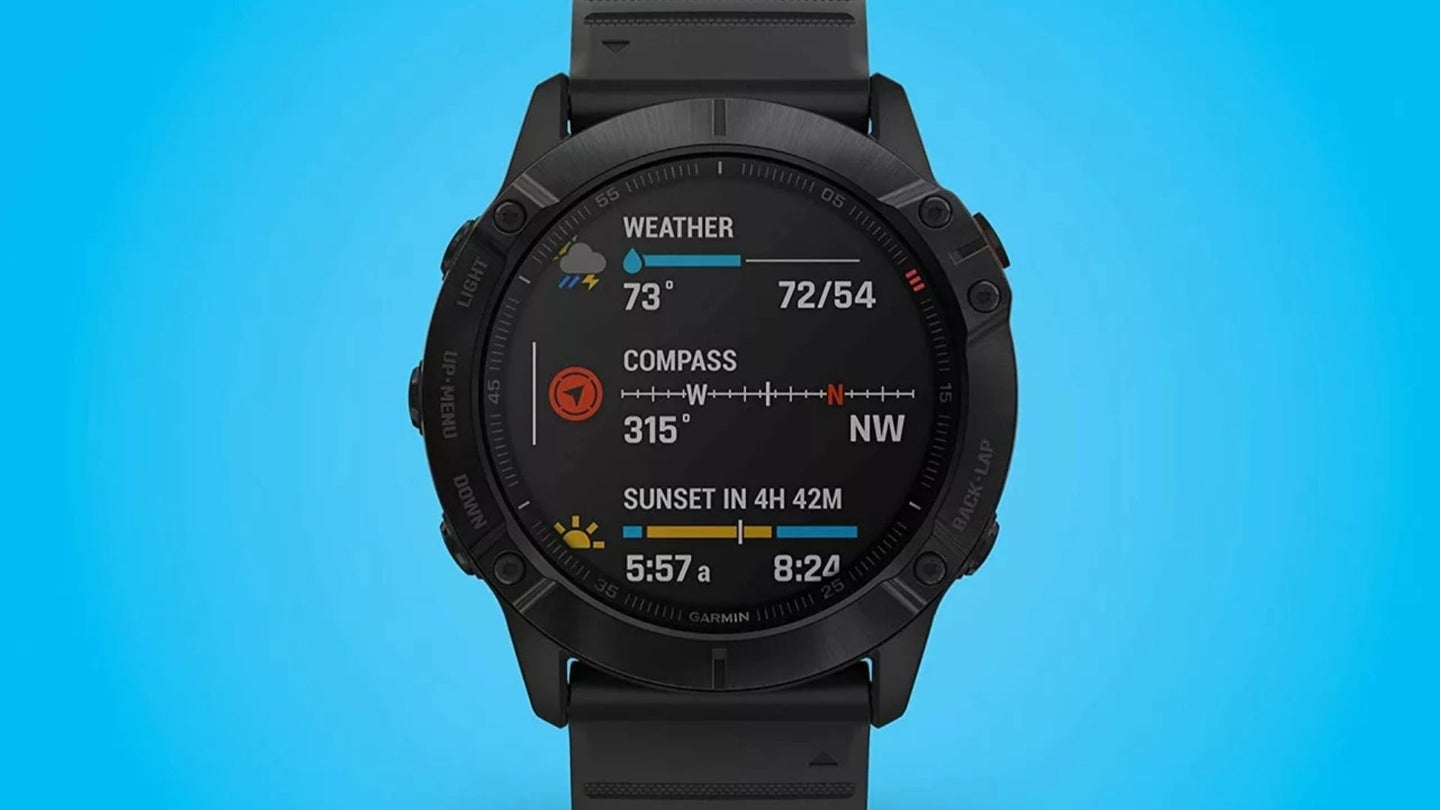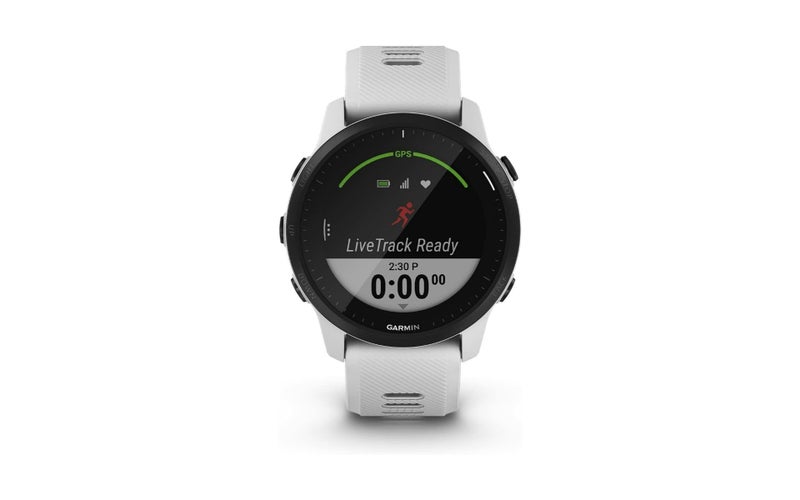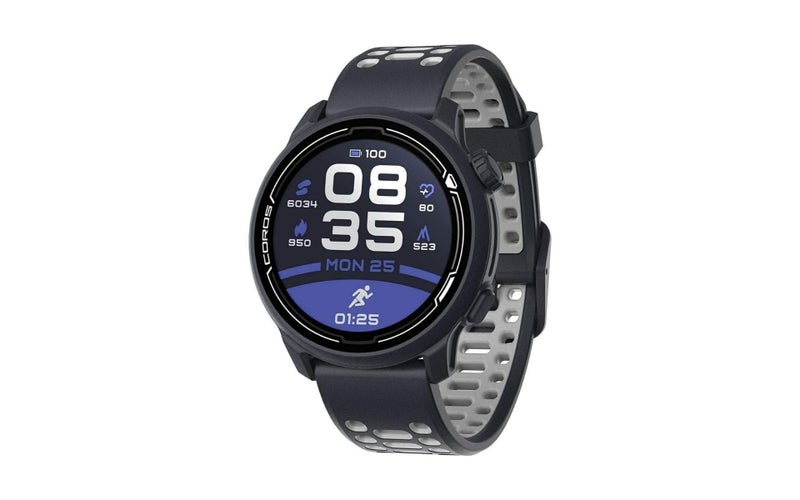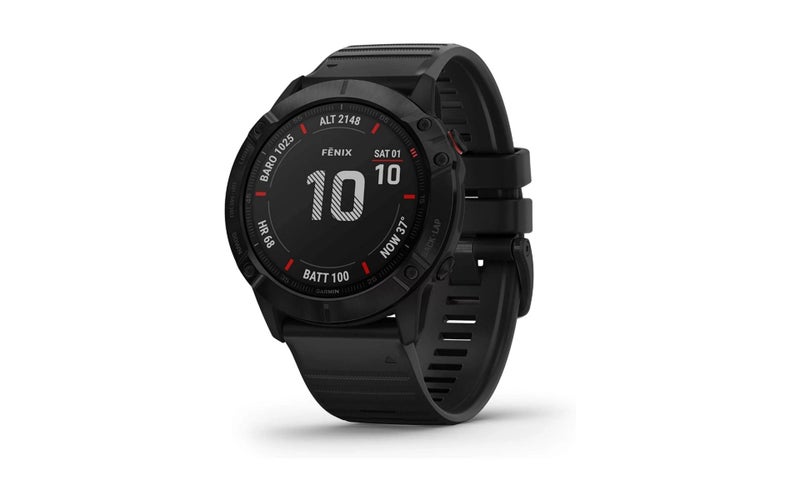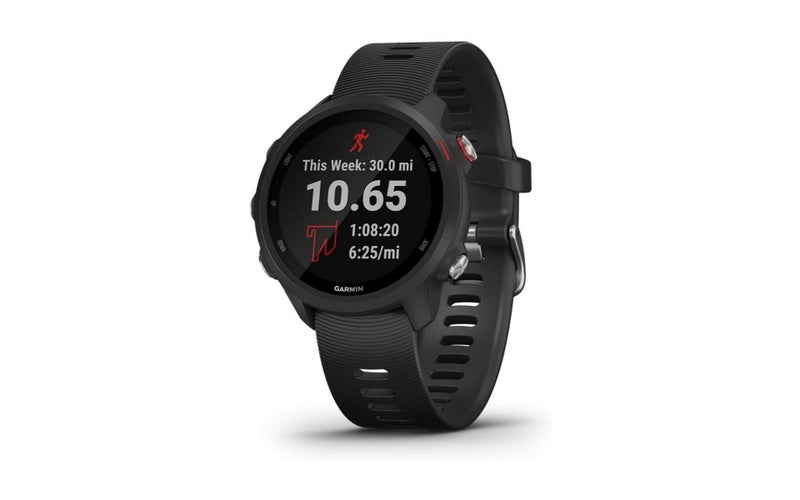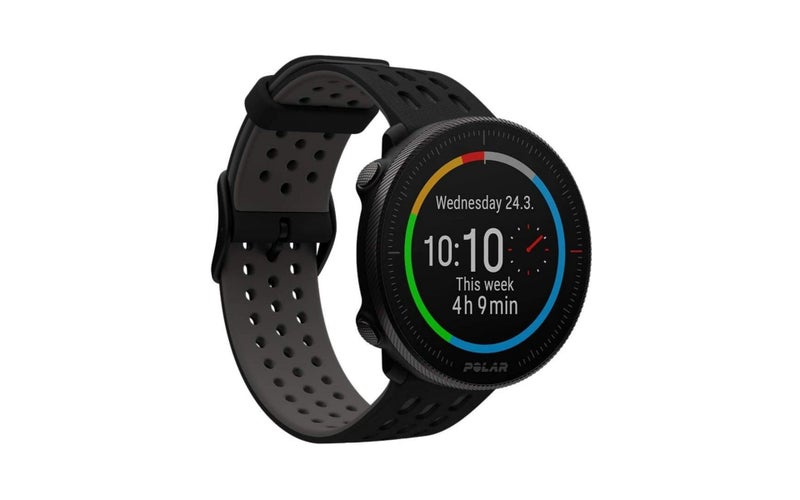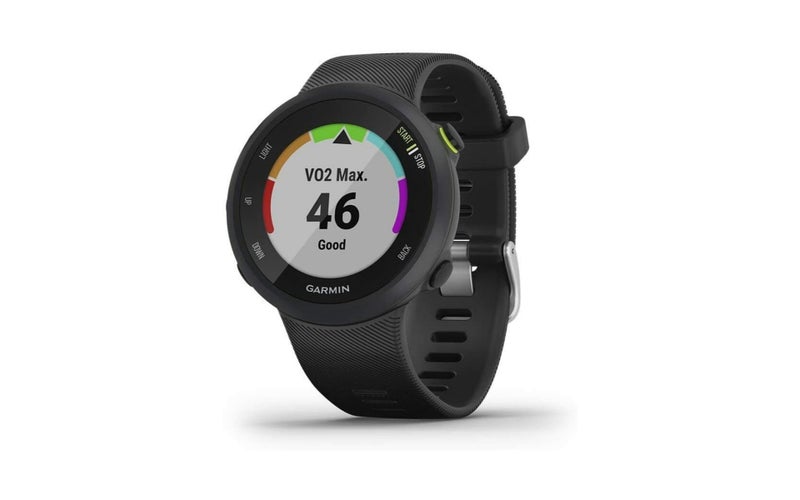We may earn revenue from the products available on this page and participate in affiliate programs.
I am not your stereotypical runner. At six feet three inches and 215 pounds, I’m what race directors call a Clydesdale. Despite this, I still get out on the trails several times a week and track my data religiously using the Strava app and heart rate monitor. I recently became dissatisfied with the battery life of my Polar heart rate monitor, so my ultramarathoner wife recommended I take a look at running watches. After taking hers for a spin, I realized I also wanted a more rugged watch with expanded GPS mapping to take into the backcountry.
To that end, I set about researching all the best running watches on the market and a considerable number of mountain watches as well. Hopefully, my research helps you find the best running watch to suit your fitness needs.
The Garmin Forerunner 945 is designed to meet the needs of elite endurance sport athletes, which makes it a favorite in the running community. With the additional LTE feature, it becomes a personal safety device that allows you to run without your phone and still send your location to designated contacts or the Garmin emergency response center should an emergency arise. rnrnThe LiveTrack feature lets your contacts follow your real-time location and send audio and text messages to you. The 945 also has daily suggested workouts, free training plans, VO2 Max indicator, a recovery time advisor, a cycling power function, and more — much more. The lens is made from Corning Gorilla Glass and the bezel is constructed from a fiber reinforced polymer. The 945 offers full color mapping, turn-by-turn navigation, round trip routing, and works off of multiple satellite systems. It will also store 1,000 of your favorite songs. If you don’t need all this functionality, check out the Garmin 245 Music.rnrnSimply put, the Garmin Forerunner 945 LTE is the top-of-the-line premium runner’s watch. It impressed the heck out of us and leads the pack in almost every other “best of” reviews we could find.rn
- Size: 44.4 x 44.4 x 13.9 mm
- Weight: 49 g
- GPS: Yes
- Heart rate: Yes, wrist sensor
- Battery life: Smartwatch up to two weeks; GPS mode w/o music up to 35 hours
- Color display: Yes
- Water rating: 5 ATM
- Memory: 200 hours of activity data
More features than most will ever need
Intuitive user interface
Accurate
Long battery life
Safety features
Expensive
When you pick up the Coros Pace 2, it’s so light at 29 grams that you might wonder if there are any parts in it, but rest assured, it is packed with features. If you run, bike, and/or swim, this is an ideal watch for people who are looking for essential functions in a low profile 42mm x 13mm package. rnrnWe had a tough time picking between the Garmin Forerunner 245 and the Coros Pace 2 for our best value running watch. They both had many similar features and received high marks from other reviewers. When we compared prices, though, Coros Pace 2 came in about $100 less than the Garmin 245. rnrnWe were also amazed that the Pace 2 had the same software as higher-end watches at such a low price — a 1.5 times increase in processing power, five times more RAM, and four times more storage over the Pace 1. We also liked the Coros Pace 2’s one-touch scroll wheel for navigating the watch’s different features. It also has amazing battery life at up to 30 hours with GPS running, and we loved that it has over 200 exercises built in covering upper and lower body and core work. Crossfit fanatics will appreciate the muscle heatmap function showing which areas of the body were most worked. Of note, the Pace 2 outperforms most other similarly priced watches in tracking elevation since it has a barometric altimeter, so it will track indoor stair climbing where GPS reliant watches can’t. Lastly Coros offers a two-year warranty, which is two times longer than Garmin’s. rnrnWhen compared to its competitors, the Coros Pace 2 blew their doors off delivering most of the features of premium watches for hundreds of dollars less. If price is a concern, dollar for dollar this is the best running watch out there. rn
- Size: 42 x 42 x 13 mm
- Weight: 29 g
- GPS: Yes, but no extra navigation features
- Heart rate: Yes, wrist
- Battery life: Up to 20 days of daily use, and up to 30 hours with GPS running
- Color display: Yes
- Water rating: 50m water-resistant
- Memory: N/A
Very affordable
Has essential features
Easy to use
Long battery life
Accurate heart rate monitor
Accurate GPS system
Nylon strap option retains water
Some user reviews say digital crown wheel hard to operate while running
Lacks navigation features
Garmin continues to produce outstanding watches, and if you’re looking for a watch rugged enough for the backcountry with all the bells and whistles of the Garmin Forerunner 945, this is the watch for you. Whether you’re running the Leadville 100 trail ultramarathon or guiding Mount Rainier, the Fenix 6 has everything you need, but it also comes at a premium price. rnrnThe Fenix 6x Pro is the largest of the Fenix line with a 51mm bezel, although it also comes in 47mm and 42mm sizes with slightly different features. Within the sizable case is a wrist heart rate monitor with fitness tracking, GPS tracking with preloaded maps, preloaded activity profiles for trail and track running, swimming, biking, hiking, rowing, skiing, and golfing, music storage, sleep tracking, hydration tracking, blood oxygen monitoring, altitude acclimatization monitoring, an emergency beacon, and crazy long battery life. There’s also a solar-powered option as well. The 6X also has a cool battery power manager that allows you to determine how the use of different functions impacts battery life. This watch literally does everything. It has backcountry ski, cross country ski, mountain bike, surfing, and even golf functions (access to 41,000 golf course maps). rnrnThe GPS system can access multiple global satellite systems to include GLONASS and Galileo and has integrated ABC sensors to include an altimeter, barometer, and three-axis electronic compass. The 6X can store topographical maps and comes with maps for more than 2,000 worldwide ski resorts. It will also support round-trip routing and turn-by- turn navigation. The Fenix 6X Pro can also receive emails, texts, and alerts when paired with a compatible device and can store up to 2,000 songs to power you down the trail. rnrnThe Garmin Fenix 6X Pro is the Cadillac of outdoor running watches. Chock full of functions, it will do everything you need it to do, and then some. Most importantly, it has a superb sensor to track all your physiological data, an outstanding navigation system, and exceptional battery life — all in a ruggedized package.rn
- Size: 51 x 51 x 14.9 mm
- Weight: 93 g
- GPS: Yes
- Heart rate: Yes, wrist sensor
- Battery life: Smartwatch up to 21 days, GPS mode without music up to 15 hours
- Color display: Yes
- Water rating: 10 ATM
- Memory: 32 GB
Staggering array of features
32 GB of storage
Intuitive interface
Accurate sensors
Long battery life
Expensive
Chunky, heavy and bulky
Takes up the space of a small rodent on your wrist
We had a tough time picking between the Garmin Forerunner 245 Music and the Coros Pace 2 for our best value running watch. They both had many similar features and received high marks from other reviewers. Both have similar display sizes, long battery life, workout performance tracking features, accurate GPS, and solid heart rate sensors. So what do you get by shelling out around $150 more for the Garmin 245? Well, for one, music — up to 500 songs on your wrist via Amazon Music, Spotify, or Deezer. rnrnFor those who love activity data, the 245 has a PacePro that helps you pace your race while accounting for elevation and target time. It also tracks your yoga workouts, stair stepper (boring!), elliptical workouts (also boring!), cardio, and trail running. For the latter, the 245 also has breadcrumb navigation to keep you on your pre-planned track. The Forerunner 245 Music also enables you to adjust your screen brightness, track menstrual cycle, monitor your body’s energy levels, check your blood oxygen saturation levels, monitor stress, and also track your running shoe mileage so you know when to replace them. If you want all the functionality of the Coros Pace 2 and then some, the Garmin Forerunner 245 is worth a look. rnrnHands down, the Garmin Forerunner 245 is a crowd favorite in the running and triathlon world. If music is important to you during workouts, this is a solid choice. We also liked the increased functionality the 245 offers over the Coros Pace 2.rn
- Size: 42.3 x 42.3 x 12.2 mm
- Weight: 38.5 g
- GPS: Yes,
- Heart rate: Yes, wrist
- Battery life: Up to 7 days of daily use, and up to 6 hours with GPS and music
- Color display: Yes
- Water rating: 5 ATM
- Memory: 200 hours of activity
Affordable
Has essential physical performance tracking features
Intuitive, easy to use
Good battery life
Accurate heart rate monitor
Accurate GPS system
No barometric altimeter
Takes longer to connect with GPS signal
Lacks navigation features, topographic maps
If you’re looking for a reasonably priced multisport watch with many premium functions, the Polar Vantage M2 might be the watch for you. Polar designed the Vantage M2 specifically to support multisport (swim/bike/run) athletes. In fact, it has more than 130 sport modes built within. rnrnNew for 2021 is a fueling option that reminds you to eat and hydrate during those long distance efforts. The M2 will also provide you post-workout reads on what energy you used during your effort in terms of total calories with carbohydrate, protein, and fat breakdowns. Polar also improved the weekly training summary dashboard featuring total time, distance, number of workouts, calories expended, and heart rate zones. They’ve also improved the battery saver mode which allows you to extend battery life by reducing GPS usage from every second to every minute or every two minutes (which will also degrade workout data quality), turn off the wrist-based heart rate sensor, and adjust the screen saver. rnrnOne of the things we also liked about the M2 is it’s weather forecast function and its capability to customize watch face dashboard views. Of note, unlike the Garmin Forerunner 245 Music, the Polar Vantage M2 has no music storage capability, but you can control your phone’s music settings from the watch. rnrnThe Polar Vantage M2 is purpose-built for people who are looking for a capable multisport watch at an affordable price. If you are a workout data junky and need something that will connect to all your sensors and support activities beyond traditional run/bike/swim activities, give this watch a serious look.rn
- Size: 46 x 46 x 12.5 mm
- Weight: 45.5 g
- GPS: Yes, also GLONASS, Galileo and QZSS capable
- Heart rate: Yes, wrist
- Battery life: Up to 7 days of daily use, and up to 40 hours with GPS and heart rate
- Color display: Yes
- Water rating: WR30
- Memory: N/A
Affordable
Has essential physical performance tracking features
Decent battery life
Accurate heart rate monitor
Decent GPS system
No barometric altimeter
No route navigation
Long time to synch with
GPS No touchscreen
If you’re not looking for advanced features and just want a basic running watch that will accurately track your pace and distance, monitor your heart rate, track your sleep, and has some basic notification capabilities, you can snap up a Garmin Forerunner 45 for about $129. Keep in mind, the Forerunner 45 has a shorter battery life, doesn’t have an altimeter, and doesn’t come with Pulse Ox to track blood oxygen saturation. rnrnIt also doesn’t have music or Garmin Pay. Also, the model is a few years old. If you’re willing to pay another $70, we recommend the Coros Pace 2 over the Garmin Forerunner 55. Both are about $200, but the Coros Pace 2 blows the doors off the Forerunner 55. This is a basic watch: We don’t love it, but if you are looking for a bargain basement option to get you started, this is a good pick.
- Size: 42 x 42 x 11.4 mm
- Weight: 36 g
- GPS: Yes, also GLONASS, Galileo
- Heart rate: Yes, wrist
- Battery life: Up to 7 days of daily use, and up to 13 hours with GPS and heart rate
- Color display: Yes
- Water rating: 5 ATM
- Memory: 80 hours of activity data
Super affordable
Has basic physical performance tracking features
Decent heart rate monitor
Decent GPS system
No barometric altimeter
No route navigation
No music
Short battery life
Dated model
Why you should trust us
I have more than 35 years of experience living and working outdoors with the tools I recommend. I’m an avid long-distance backpacker, rock climber, and mountaineer who understands the value well-designed gear delivers, especially when your life depends on it. I don’t get paid by the manufacturers and have editorial independence. My editor leaves it to me to recommend and prints what I write. All of this enables me to provide you, our valued readers, with our unvarnished, honest opinions on the recommendations we make.
Types of running watches
Running watches all pretty much do similar things. They track pace and distance of workouts accurately with GPS, monitor heart rate and caloric burn, and provide post-workout feedback. Typically, the higher prices include increased functionality, longer battery life, music/data storage, and navigation features.
Basic
These watches are simple in design and focused on supporting runners. They’ll track pace and distance, heart rate, and provide post workout feedback. So whether you’re focused on learning more about your workouts through data or tracking the distance and intensity of workouts, a basic running watch will support you.
Multisport
These are also known as triathlon watches for people who run, bike, and swim. Multisport watches typically are more versatile by design and support more activities profiles. To be a true multisport watch, the device must be able to track multiple sports in a single workout activity. Beware of watches that have run, bike, and swim functions but don’t allow you to link all three functions together in a single session.
Adventure
These watches have all the physio data of a running watch with the addition of navigation capabilities, to include topographic maps and point-to-point tracking, and have extended battery life to allow you to spend days in the backcountry without a recharge. These watches typically weigh more because they’re enclosed in more polymer and more durable components than basic running watches.
Key features of running watches
Heart rate monitoring
A good heart rate sensor is essential in tracking the intensity of your workout. These watches use an optical heart rate sensor that tracks the movement of blood through illuminated capillaries. If you want to increase the accuracy of these measurements, most models can accommodate the addition of a chest strap. The HRM function also provides you real-time data to show how hard you are pushing yourself on that hill or sprint, and how quickly (or not) your body recovers in session.
GPS tracking
GPS tracking enables you to measure distance and speed, get accurate time, and check out your workout tracks.
Navigation
Advanced running watch models enable you to navigate off trail through topographical map uploads, barometric altimeters, and integrated digital compasses.
Benefits of running watches
Train smarter
Running watches help you better track each workout, target areas for improvement, avoid sandbagging (through real-time data), and help motivate you to workout more and longer.
Hands-free use
Sure you can take your expensive and clunky phone along, trip, drop it, and crack the screen into a bajillion pieces, or you can just leave it at home and head out with a running watch.
Find your way home
Whether running through the woods on unfamiliar trails or in a new city, a running watch makes it easy to find your way back to the trailhead or your hotel — and more importantly, the hotel bar.
Pricing considerations for running watches
Budget
If you just want distance, pace, time, heart rate, date, and some activity tracking, you can find a basic running watch for $120 to $199.
Mid-grade
Do you want some more bells and whistles that gather training data, provide you workout recommendations, and has a longer battery life? You can find mid-grade watches in the $200 to $499 range.
Premium
Is money no object? Are you a data addict? Do you have a third lung and insane VO2max? Then you can find a premium advanced running or multisport watch for $500 and up. Want to get stupid and drop $1,700? Check out the Garmin MARQ Athlete Performance Edition.
How we chose our top picks
The watches recommended in this review were selected based on hands-on inspection, interviewing other experts, and thoroughly reviewing manufacturers’ specifications. We take our time to get to know the strengths and weaknesses of each item, and also check out the reviews of other experts just to make sure we’re not missing anything.
FAQs on running watches
You’ve got questions, Task & Purpose has answers.
Q. What should I look for in a running watch?
A: At a minimum, you’re going to want a watch that accurately tracks your heart rate and GPS position, and provides you feedback on your workouts so you can target performance improvement.
Q. What is a good running watch for beginners?
A: If you are looking to try a running watch but aren’t fully committed to paying hundreds of dollars for capabilities you might not need, check out the Garmin Forerunner 45. It’s basic, but will give you the basics: heart rate, GPS tracks, access to Garmin Coach, smart notifications, incident detection and assistance, and up to seven days of battery life — all for just over $100.
Q. How useful is a running watch?
A: Not to be cute, but it’s as useful as you make it. I’ve found that tracking workout data motivates me to exercise more frequently and longer. It also helps track your weekly workouts to keep you honest. You’ll train better with better data, and that’s the whole point.
Q. Running watch vs. fitness tracker?
A: If you want to accurately track your workout distance and pace and want to leave your phone at home, get a GPS running watch. If you want to track your walking or stair climbing, but accuracy isn’t a priority, get a fitness tracker.
Q. How much should I spend on a fitness watch?
A: It depends. If you want a basic watch, about $120. If you want some premium functions but not a premium price, about $250. If you want the very best, you’re looking at $550 and up.
Q. Do I need a running watch?
A: No. You can get off your ass, lace up your running shoes, and run — but you won’t get any workout data that way and might get lost because you don’t have GPS and you failed land nav class.
Our gear section
Joe Plenzler is a Marine Corps veteran who served from 1995 to 2015. He is a backcountry expert, long-distance backpacker, rock climber, kayaker, cyclist, wannabe mountaineer, and the world’s OK-est guitar player. He is currently section-hiking the Appalachian Trail with his partner, Kate Germano. He supports his outdoor addiction by working as a human communication consultant, teaching at the College of Southern Maryland, and helping start-up companies with their public relations and marketing efforts.
